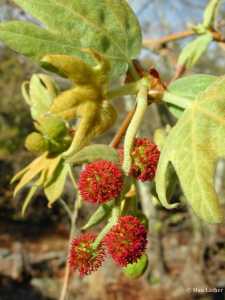Trees , deciduous, to 50 m. Trunks 1-several, erect to prostrate. Bark smooth at first, exfoliating in thin plates, exposing conspicuous mosaic of chalky white to buff or greenish new bark, becoming dark, thick, and fissured with age. Axillary buds: each hidden by swollen base of petiole. Leaves alternate, simple; stipules sometimes persisting, green, prominent, sheathing stem, flaring, margins entire to serrate. Leaf blade palmately (0-)3-7-lobed, base cordate, truncate, or cuneate; surfaces tomentose or glabrescent. Inflorescences axillary, solitary, appearing with leaves; staminate inflorescences with heads soon falling, 1-5, green, sessile, globose; pistillate with heads 1-7, terminal (and in some species lateral), sessile or pedunculate, globose, the whole much elongate and pendulous in fruit. Flowers unisexual, staminate and pistillate on same plants, very crowded, 3-4(-8)-merous, inconspicuous; perianth hypogynous, minute. Achenes maturing in fall, often persisting until spring, tan, club-shaped, quadrangular, with terminal stylar beak, surrounded by numerous hairs; hairs basally attached, thin, unbranched, 2/3 to nearly equal to length of achene.
The family is well known in the North American fossil record and was once more widespread in the flora (S. R. Manchester 1986).
Native species of the flora area are cultivated for shade and ornament in and beyond their native ranges, as are a European species and a hybrid with many cultivars (F. S. Santamour Jr. 1986). The sycamores are known for their great size, imposing stature, smooth and light-colored bark, and tolerance of pruning. The trichomes falling from the new growth reportedly cause irritation to mucous membranes. The wood is difficult to work and therefore has limited commercial value; its resistance to splitting makes it useful for butcher blocks and buttons, hence the old vernacular name buttonwood.
Phytochemical, morphologic, and anatomic characters are summarized for the family by R. N. Schwarzwalder Jr. and D. L. Dilcher (1991).
PLANTS: Monoecious trees with branching hairs; bark peeling off in irregular sheets revealing a smooth surface.
LEAVES: deciduous, alternate, simple palmately lobed or rarely merely toothed, palmately or rarely pinnately veined; stipules thin, sheathing, entire or lobed; petioles dilated at base and enclosing the axillary bud.
INFLORESCENCE: dense, globose, unisexual heads, these solitary or arranged in racemes.
FLOWERS: sepals 3-8, united or distinct, inconspicuous, scale-like, sometimes absent in staminate flowers; petals 3-6, minute, longer than sepals; petals of staminate flowers cuneiform-sulcate, scarious pointed; petals of pistillate flowers acute, sometimes absent; stamens as many as the sepals and opposite them; filaments very short to obsolete; staminodes in pistillate flowers 3-4; carpels (3-)5-8(-9), separate, l-loculed, in 2-3 whorls, surrounded by persistent hairs, ovaries superior; styles terminal, long, slender the stigmas along the inner face; ovules 1-2; rudimentary carpels sometimes present in staminate flowers.
FRUITS: densely hairy achenes or small nutlets.
SEEDS: elongate-oblong, pendulous.
NOTES: one genus Platanus.
REFERENCES: Laferriere, Joseph E. 1994 Platanaceae. J. Ariz. - Nev. Acad. Sci. Volume 27, 238.
not available
not available
not available
not available
not available
not available
not available
not available
not available
not available
not available
not available
not available
not available
not available
not available
not available
not available
not available
not available
not available







